As I walked through the security checkpoint, the guard looked me over for visible weapons. He spied the clip on my left pocket and pointed at it. With a smile, I withdrew the flashlight that was clipped there and held it up for him to see. I’m certain he initially thought that it was a knife clipped to my pocket, but when he saw that it was “only” a flashlight, he nodded me through the checkpoint.
He made two mistakes:
1. The first was that he likely had no idea of the amount of mayhem that I could cause using that “mere” flashlight. Its potential as a striking device is amazing.
2. The second was that he never looked at my right pocket, where there was, indeed, a folding knife visibly clipped. He ASSUMED that using his superior observation skills, he’d detected all of my weapons.
Yeah, I know it goes against “the rules”, but being forced to be unarmed and at the mercy of attackers violates “my rules”, so I guess we’re even on that one. I’ll admit, I’ve never been much of a conformist. I choose to be armed and in control of my own security whenever it is physically possible.
Defensive Weapons — A Dose of Reality
I’m no stranger to security checkpoints and measures, having worked for 29 years in my state’s prison system. Over the years, I picked up various tips and tricks on how to get things from Point A to Point B when folks might not want that to happen. I may or may not have invented a few ways to do it myself. Certainly, I paid close attention to all that the inmates had to teach me (I could fill volumes with that information), and my coworkers also came up with some methods.

“Security is inconvenient, and people do not like to be inconvenienced.” —Dick Marcinko, SEAL Team Six.
The above statement is more true than you can ever imagine. Securing an area or building is an immense, time-consuming pain in the ass that requires everyone to be on their toes every second of the day. And, it is virtually impossible to do with 100% success. In many places, much of the show that Security puts on is just that—a charade.
In the mid-1980s, the prison where I worked experienced an attempted escape by several inmates, and when that was unsuccessful, a week-long hostage siege followed as the would-be escapees took several inmates and staff hostage. What sort of weapons did they use? I’m so happy that you asked! It was only two Remington 870 12 gauge pump-action shotguns and a host of pistols. Mind you, this was a prison surrounded y 35-foot walls, gun towers, and metal detectors! Somehow, the inmates had managed to smuggle in a small arsenal of weapons, which they then put to use.

Beyond that, over my career, I’ve seen more homemade weapons produced inside that prison than there are minutes in a year. Not to mention all the contraband that was smuggled in from the outside, including drugs and cell phones.
Since we were required to be unarmed while inside the facility, I always had a flashlight and often a tactical pen on my person.
Like I said…there is no 100% success.

How does this affect us?
What’s all this have to do with you and me? Knowing human nature is a huge part of the equation as far as you being able to equip yourself with the tools you need to safeguard yourself.
Security is wonderful and all, but you know who I trust with my personal security and safety? Me! Yes, I’m the only one whom I trust with such important matters. As such, I like to have an implement or three on me that helps me to keep myself safe and equipped.
Sure, I can use my hands and feet to fight and have done so on more occasions than I’d care to relate. That said, it’s nice to have tools to work with if I’m able to because they give me an advantage.
Tools as Weapons
The Flashlight
A few times, when going through security checkpoints, I was asked the question, “Why do you have a flashlight with you.” Without missing a beat, I replied, “I use it to see in the dark.” Reactions are sometimes mixed, ranging from a chuckle to a perplexed look that I was sure was causing the person who asked me the question a measure of physical pain.
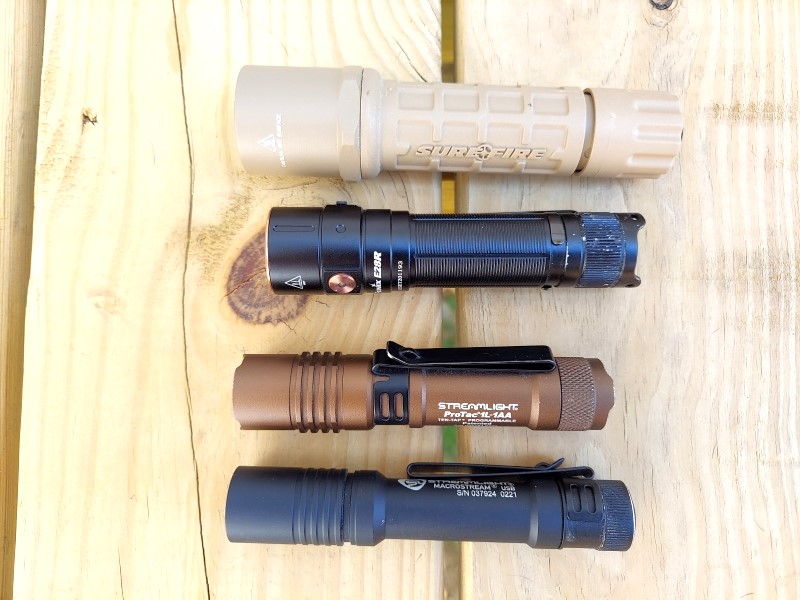
A flashlight is a relatively “harmless”, innocent-looking piece of gear. Now I’m not necessarily talking about the tacti-cool versions that have cutouts in the bezel that are obviously intended for striking and tearing out large pieces of flesh from your attacker’s skin. Those certainly are fun aspects for some flashlights, but there’s a good chance that the particular light will then be seen as a weapon and it will be barred access. And we don’t want that.
No, I’m talking about a light that appears to be innocuous, one that few people will bat an eyelash over. But how much damage can we do with a simple, hand-held flashlight? I’m talking about a light that uses a AA battery or two, or a CR123 battery or two, or maybe even a slightly smaller light. It doesn’t have to be a large, long, heavy light (although those will certainly do their share of damage). It need not be an expensive light, either; in fact, sometimes a less expensive light might be preferable in case it is lost or confiscated.
There are many brands out there at various prices: Surefire lights are excellent, but some can be pricey (the Surefire G2, seen above, is a good light for a modest price). Fenix and Streamlight offer some good ones for more modest prices. There are many other brands that would work too.
The reality is that we can concentrate a decent amount of force in our strikes with a modestly-sized light. It’s a hard, metal object, and when swung with intention, it can cause enough pain to make some people back off and rethink whether or not they want to harm us.
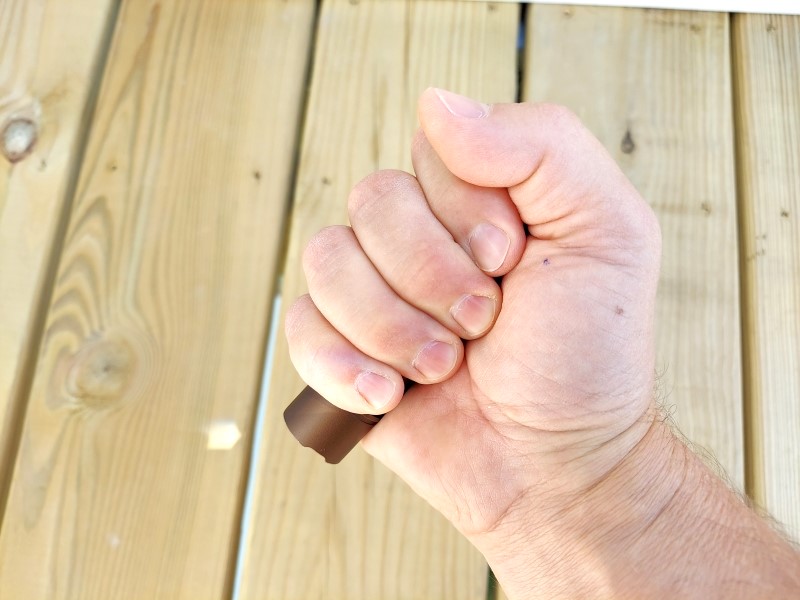
Aside from striking our attackers, the better lights will also be bright enough to temporarily blind them. If you doubt this, take one of the brighter lights and try it out on yourself. A high-lumen output light can really be dazzling to one’s ability to see, especially in dim light conditions.
The Pen
Another item these days that’s all the rage is the Tactical Pen. Prices range from $10 all the way up to several hundred dollars each. As with the flashlights, the smarter way might be to go with the pens is the less expensive route. If yours is seen as a weapon and confiscated, you don’t want to be out a couple of hundred bucks.
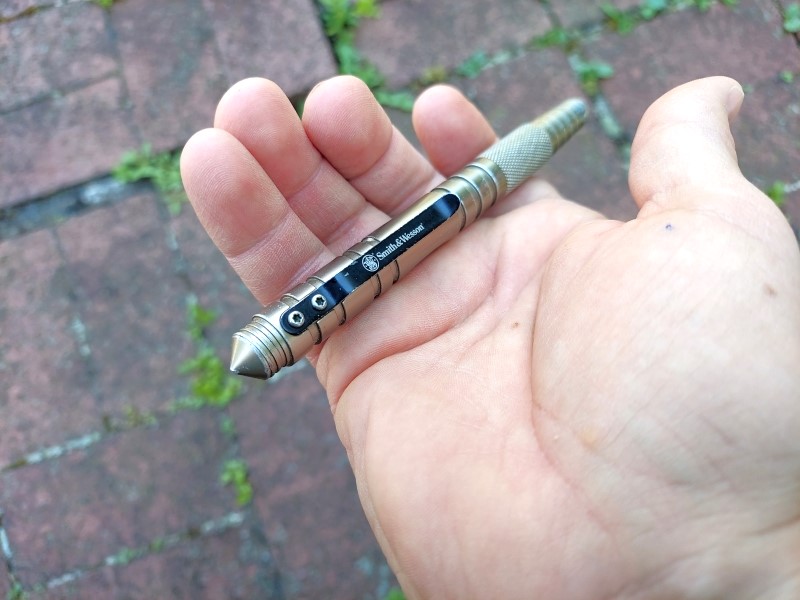
Some of these pens have wicked striking tips that are serious weapons and can inflict a respectable amount of damage.
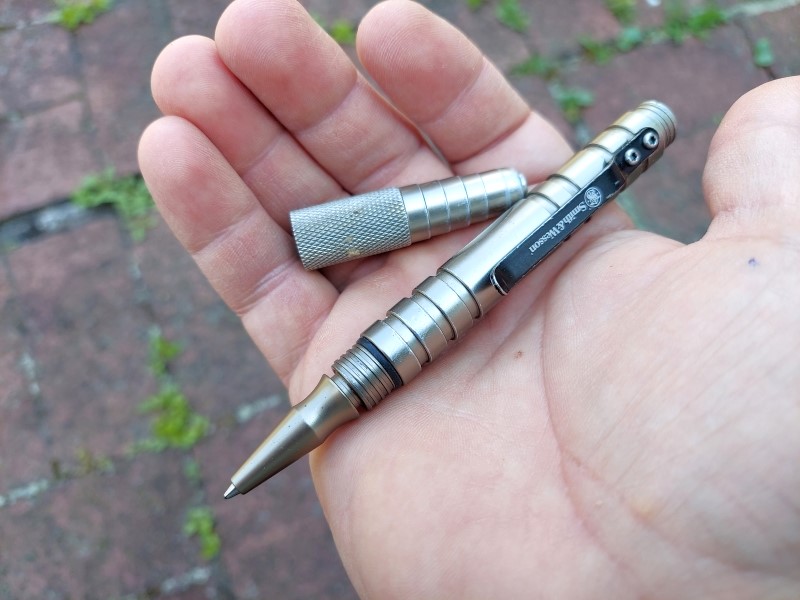
A bit of an offshoot to the tactical pens is to simply get yourself a good, sturdy, metal pen at an office store. Not necessarily a high-dollar item, but such a pen will set you back a bit more than a 20-pack of plastic pens that you’d buy for the office. The last time I priced a nice set of pens, you could grab them for maybe $20-$30 or so. The nice thing about these is that you can locate them in any decently equipped office supply store, so they’re readily available.
Of course, you could spend more if you’d care to, as with anything else. You’re just after something that will allow you to deliver several stabs to an attacker, and a metal pen will generally do that. The nice thing is that assuming you never have to stab an attacker with them (and let’s face it, there’s every chance that you’ll never have to), you have a nice set of pens to write with in the meantime.
If you have a normal pen, it is not very likely at all that this will be seen as a weapon. Again, we’re going for the “Armed in plain sight” philosophy.
A friend who is a former Navy SEAL related a story a couple of years ago in which he was about to board a plane and the TSA folks went into panic mode because he had a tactical pen. They told him he couldn’t take it on board with him, and much drama was caused by the offending pen. Ironically, once the pen was no longer in his possession, they required him to sign a form. He helpfully pointed out that he’d like to, but that he no longer had a pen with which to sign the form in question. So they gave him one of their pens to use. And there you have it, folks, our helpful government hard at work!
The bottom line is that tactical pens are often looked at as exactly what they are—weapons intended to be used as stabbers. Don’t count on just being able to explain it away as “it’s just a pen.”
Keys
I’ve often seen people suggesting that we grip our keys, pointing each key between and through our fingers to use as a sort of “Brass Knuckles” affair for striking an attacker. I do not believe this would be a realistic or good approach. First of all, it takes time to arrange the keys in such a fashion. Next, you will likely succeed more in hurting your own hand than you will anyone else. I’m not a fan of this and do not recommend the practice.
Other Implements and Improvised Weapons
Sometimes we’re carrying all sorts of things that might offer defensive use. Perhaps it’s an umbrella, as they’re typically seen as being relatively harmless but could be used for striking. A cane might also be an option, especially for…ahem…the older generation (hey, I’m not poking fun, I’m almost there myself!).
A simple screwdriver can be as devastating as a knife and is often not seen as a weapon, especially if you are carrying other tools. A hammer can also work, by the same token.
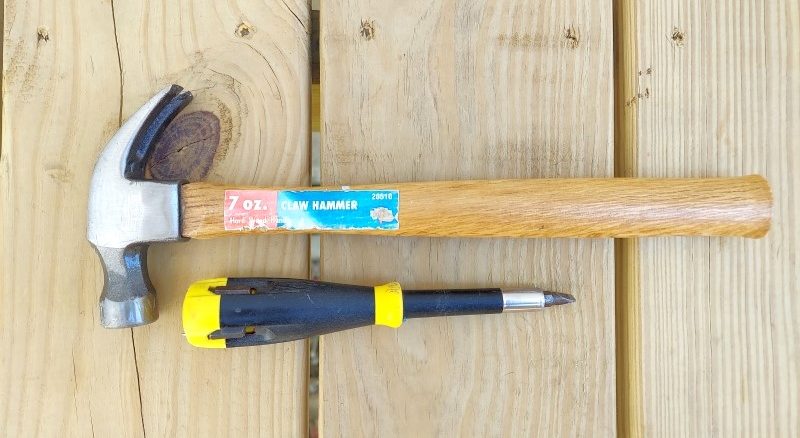
If you work in an office, that two or three-hole paper punch on your desk might be useful for delivering a strike to an attacker (however, if it’s sitting out on your desk and he has access to it, be sure that it’s not used against YOU).
There are also weapons made from G-10 and other plastics that will pass through metal detectors without setting them off. Detectors at airports, because they show images, will detect such items, so be aware of that. Some of these items come in the form of spikes, knives, and punch daggers, among others.
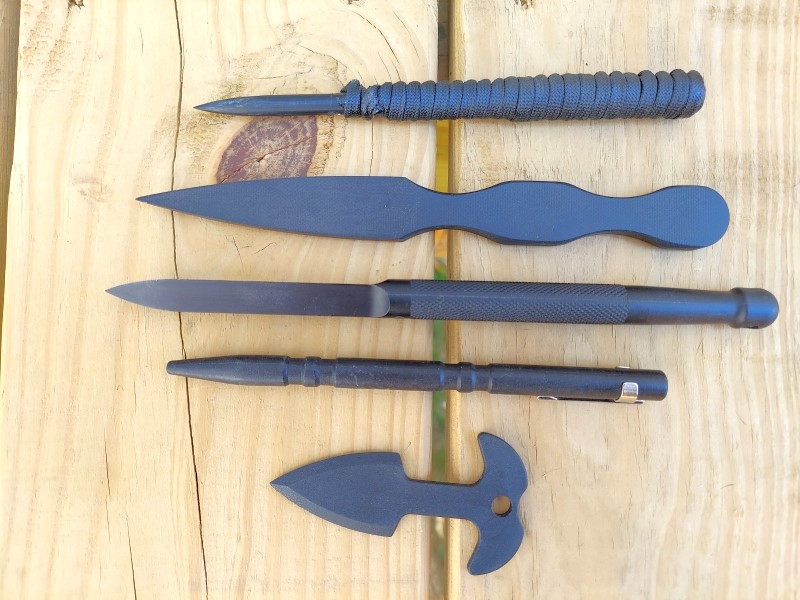
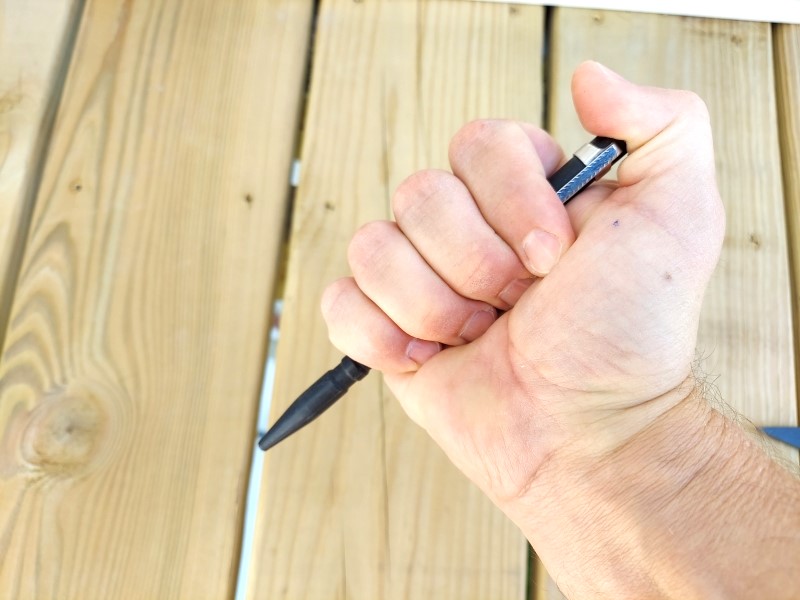
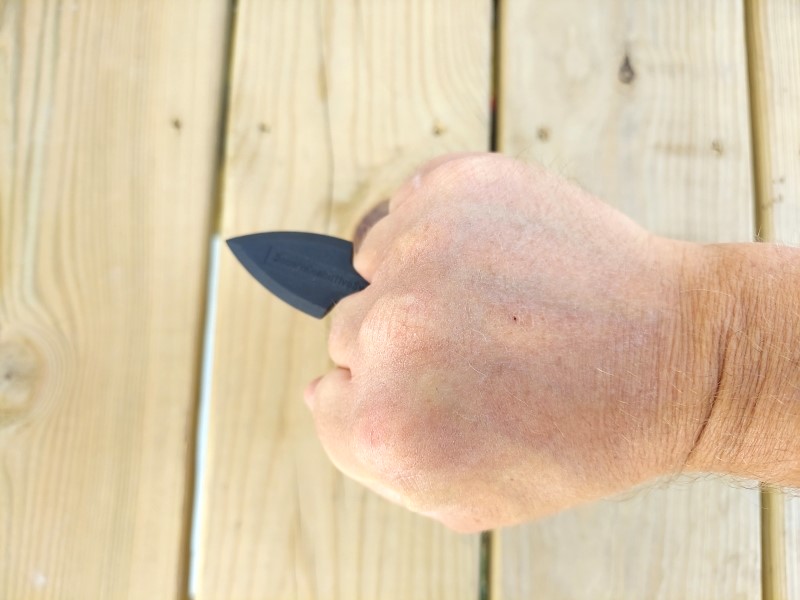
A rolled-up magazine can be used, with the end being used to strike an attacker. As with the flashlight, the end of the magazine concentrates the force of the strike into a smaller area than our fist would deliver.
Using anything to strike an attacker is often preferable to using our fist because our fist can be injured, even broken. So why not let an inanimate object take the brunt of it? Plus, said object will likely cause more pain.
The old prison trick of using a padlock dropped into a sock or with a shoelace tied to it, wielding this combination as a mace is always pretty effective.
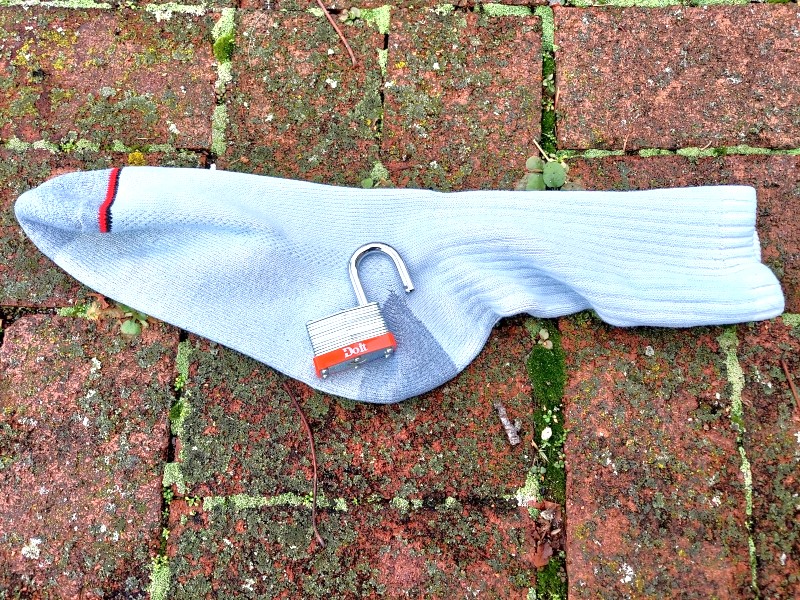
Truly, the main thing limiting your choice of weapons is your imagination. There are plenty of things in our everyday environment that can be used to defend oneself that don’t necessarily have to be firearms or knives. Though firearms and knives are the most effective, we may not always have access to those items, so we make do with what we have available. I’m just listing a few here, but there are many more.
Targets And Strategies
Areas to try to hit that offer the most advantage, depending on the seriousness of the assault, are the face and eyes. When a person has his eyes attacked, his normal reaction is to try to protect them, which may allow us time to get away. Focus your attack and deliver fast, repeated strikes to vital areas.
Hold the pen, light, or whatever you’re using like a knife in the Ice Pick grip and slam away on your attacker. If two or three strikes aren’t effective, try 10 or 20. Keep slamming away at them, don’t be discouraged. Launch a brutal series of strikes until the attacker retreats or goes down.
If the attacker has a weapon, such as a knife, in his hand, you may want to consider doing what the Filipino Martial Arts systems refer to as “Defang The Snake.” In short, attack the hand holding the weapon so that it can no longer hold the weapon. That might mean using your light or pen to stab the attacker’s weapon arm or hand repeatedly until he drops his weapon or breaks off his attack.
In Summary
There are no hard and fast rules for this type of stuff. You have to get creative and think on your feet for improvised weapons. If you’re attacked, be ruthless and survive at all costs.

Be observant of items that you can use to your advantage as defensive weapons. As always, Situational Awareness will tip you off before trouble comes knocking at your door, so stay alert. You can head off many problems before they rear their head. Not being there when the problem arrives is the very best strategy. Avoidance is king.
And you need never be completely disarmed! Be armed, without actually being armed.



Pingback: Armed — In Plain Sight, When You Can’t Carry – Guns and Pride()
Pingback: Weekend Knowledge Dump- July 22, 2022 | Active Response Training()
Pingback: Armed — In Plain Sight, When You Can’t Carry — The Tactical Hermit | Vermont Folk Troth()